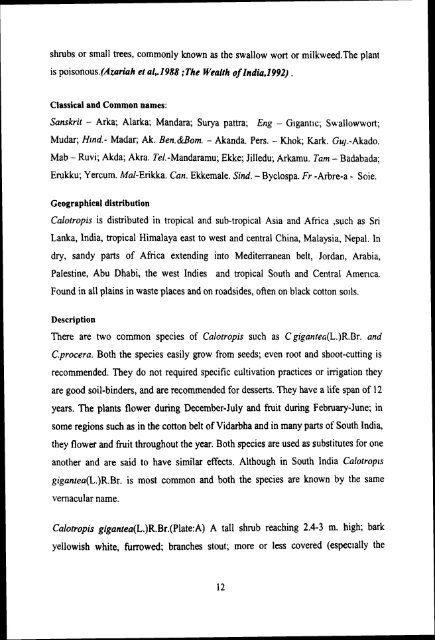impact of latex and plant extract of and the recovery of latex toxicity ...
impact of latex and plant extract of and the recovery of latex toxicity ...
impact of latex and plant extract of and the recovery of latex toxicity ...
- No tags were found...
Create successful ePaper yourself
Turn your PDF publications into a flip-book with our unique Google optimized e-Paper software.
shrubs or small trees, commonly known as <strong>the</strong> swallow wort or milkweed.The <strong>plant</strong><br />
is poisonous.(Azariah el a1,.1988 ;The Wealth <strong>of</strong> India,1992) .<br />
Classical <strong>and</strong> Common names:<br />
Sanskrit - Arka; Alarka; M<strong>and</strong>ara; Surya pattra; Eng - Gigantic; Swallowwort;<br />
Mudar; H~nd.- Madar; Ak. Ben.BrBom. - Ak<strong>and</strong>a. Pers. - Khok; Kark. Guj.-Akado.<br />
Mab - Ruvi; Akda; Akra. Te1.-M<strong>and</strong>aramu; Ekke; Jilledu; Arkamu. Tam - Badabada;<br />
Erukku; Yercum. Mal-Erikka. Can. Ekkemale. Sind. - Byclospa. Fr -Arbre-a - Soie.<br />
Geographical distribution<br />
Calotropis is distributed in tropical <strong>and</strong> sub-tropical Asia <strong>and</strong> Africa ,such as Sri<br />
Lanka, India, tropical Himalaya east to west <strong>and</strong> central China, Malaysia, Nepal. In<br />
dry, s<strong>and</strong>y parts <strong>of</strong> Africa extending into Mediterranean belt, Jordan, Arabia,<br />
Palestine, Abu Dhabi, <strong>the</strong> west Indies <strong>and</strong> tropical South <strong>and</strong> Central Arnenca.<br />
Found in all plains in waste places <strong>and</strong> on roadsides, <strong>of</strong>ten on black cotton so~ls.<br />
Description<br />
There are two common species <strong>of</strong> Cal<strong>of</strong>ropis snch as Cgiganfea(L.)R.Br. <strong>and</strong><br />
C,procera. Both <strong>the</strong> species easily grow from seeds; even root <strong>and</strong> shoot-cutting is<br />
recommended. They do not required specific cultivation practices or imgation <strong>the</strong>y<br />
are good soil-binders, <strong>and</strong> are recommended for desserts. They have a life span <strong>of</strong> 12<br />
years. The <strong>plant</strong>s flower during December-July <strong>and</strong> fruit during February-June; in<br />
some regions such as in <strong>the</strong> cotton belt <strong>of</strong> Vidarbha <strong>and</strong> in many parts <strong>of</strong> South India,<br />
<strong>the</strong>y flower <strong>and</strong> fruit throughout <strong>the</strong> year. Both species are used as substitutes for one<br />
ano<strong>the</strong>r <strong>and</strong> are said to have similar effects. Although in South India Calotroprs<br />
giganlea(L.)R.Br. is most common <strong>and</strong> both <strong>the</strong> species are known by <strong>the</strong> same<br />
vernacular name.<br />
Calotropis gigan~ea(L.)R.Br.(Plate:A) A tall shrub reaching 2.4-3 m. high; bark<br />
yellowish white, furrowed; branches stout; more or less covered (especially <strong>the</strong>

















